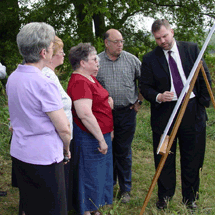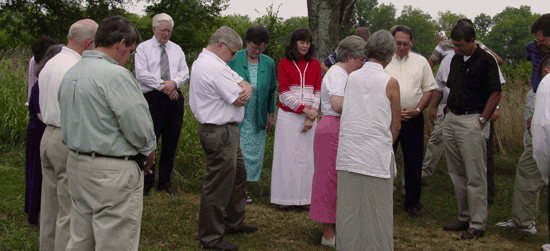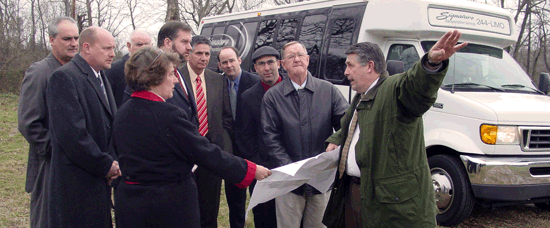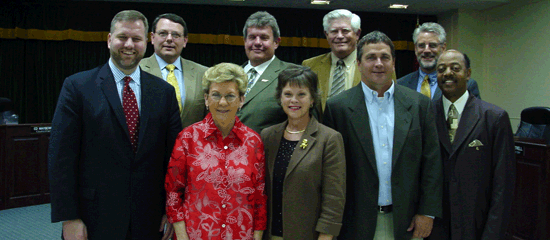 |
the gallatin decision
Behind the scenes at Free Will Baptist Bible College with the man who spearheaded the search for a new campus site.
by Mark Johnson
Find out more about Free Will Baptist Bible College at www.fwbbc.edu. |
There’s something about the excitement of a building program that energizes people and movements. Maybe it’s the smell of fresh-cut lumber, the promise of a dream becoming reality, or the simple fact that new land and new buildings call forth the best from all of us.
Biblical Precedent
That’s why when we read the Bible it should come as no surprise to discover that God keeps His eye on construction projects and building sites, on builders, designs, and master plans. Considering the detailed instructions He gave regarding design and construction of the Tabernacle and the Temple, it is apparent that God is concerned about the smallest details of at least some facilities.
The most famous building project in the Old Testament begins in I Chronicles 17 with David eager to construct a Temple as a place of worship. Although he was told that somebody else would build the structure, his son Solomon, five chapters later David is doing what he is allowed to do—gathering vast resources and launching preparations for later construction.
In an amazing sequence of events that stirred an entire generation, God’s timetable and man’s faithfulness came together to erect a holy place for a holy purpose. The entire process depicts a once-in-a-lifetime effort when God spoke and men obeyed with a sense of divine urgency. The result transformed the nation of Israel.
Historical Perspective
That same kind of holy urgency washed across the organizational meeting of the National Association of Free Will Baptists in 1935 when John L Welch gave the report of the Committee on Education. His report was adopted by a vote of the delegates, and included the following three recommendations:
-
That Nashville, Tennessee, be the location for a new school.
-
That the school begin September 1936.
-
That a campaign be launched to raise funds to finance the undertaking.
At each subsequent meeting of the National Association between 1935 and 1943, the Education Committee reported progress toward the goals for a new institution of higher learning to be sponsored and supported by Free Will Baptists. It was not until 1943, however, that the committee could report the new institution had been launched in September 1942. Free Will Baptist men and women had a place to study where the distinctive doctrines and beliefs of the denomination were taught.

Photo: College Faculty meets for prayer at the new campus.
During the 1943 session of the National Association at East Nashville Free Will Baptist Church, J.R. Davidson, business manager at FWBBC, said, “I have seen a young cause which is dearer to my heart than gold flourish and grow far beyond my fond expectations.”
From that humble beginning, God has used Free Will Baptist Bible College for 66 years to mold young lives to serve Christ and build His Church. God has used sacrificial gifts from Free Will Baptists and the life ministries of dedicated servants to shape men and women into vessels fit for His use. God has used this site, these buildings on Richland, Central, and West End Avenues, as a place of consecration and preparation for effective, lifetime service in His harvest fields.
But in order to continue its mission to educate leaders to serve Christ, His Church, and His world, the college needs a new location. Building codes have changed, neighborhood zoning policies have tightened, and more space will be needed in the future for FWBBC to provide a quality Christian education for denominational youth.
Confronting Today’s Challenge
Based on the urgency of that need, in December 2005, the Board of Trustees directed President Matt Pinson to conduct a study to determine if relocating the college campus was feasible. The college assembled a team of professionals that included real estate experts, architects, builders, community financial leaders, and capital campaign consultants to answer questions necessary for the Board to make an informed decision. Results of the six-month feasibility study were handed to the Board in July 2006. Following robust discussion and prayerful consideration, the Board directed college leaders to move forward with plans to relocate the campus.
With the help of a design team led by Hastings Architectural Associates and with input from students, faculty, and staff, the design for the new campus was begun. Using Hastings’ initial design as a basis, experienced builders provided project cost estimates. Some planning for necessary fundraising occurred. Financing partners were identified to provide necessary construction loans and long-term financing.

Photo: College Board of Trustees tours the property with Mark Johnson (far right)
But where would the college relocate? The relocation committee established criteria to guide the site-selection process before a search was undertaken. Near the top of the list was a commitment to be consistent with the policy adopted in 1935—Free Will Baptist Bible College would remain in the Greater Nashville area. The committee defined the search area as any place within a 25-mile radius of the Tennessee State Capital located in the center of Nashville.
Sites across the Greater Nashville area were considered, with more than 115 reviewed. Those that best satisfied the criteria were placed on a short list. The selection committee considered the top prospects, visited the sites, met with community leaders, studied site-development costs, and finally made a decision. When the exhaustive process was completed, it was clear that one location best satisfied the criteria. The site is located in Sumner County, a 25-minute drive northeast of the current campus.
College Board members visited the site in December 2006. Following further investigations that included appraisals, environmental studies, geo-technical analysis, meetings with city planners, studies by architects and engineers, reviews by builders, and sessions with city leaders, Dr. Pinson recommended that the Board approve purchase of the property. In May 2007, the FWBBC Board of Trustees members voted to approve the land purchase.
Closing the Deal
The process to obtain master plan approvals from the Gallatin Planning Commission and City Council took several months. The property did not require a zoning change to permit the college’s use of the site, but a review of plans with workshops and meetings with city officials was a necessary part of the process. Three readings with formal votes were required. Each reading resulted in a unanimous vote in favor of approval of the college master plan. The plan approved included all construction anticipated for replacement of the current campus.
The City Council also approved plans for future campus development to be completed as needs and resources dictate. This means the college will not have to repeat the review process each time campus expansion is necessary. The design team carefully studied the site to ensure that foreseeable future development of college programs and supporting facilities can be accommodated on the site.

Photo: President Pinson (left) with the Gallatin City Council.
Final approval from the city was obtained July 15, 2008. The contract was finalized August 15, 2008. FWBBC’s future home was purchased for $2.96 million.
From the outset, property owner Dan Downs expressed his desire to sell this property to FWBBC because of his support for the college’s ministry and the positive impact the college would have in the community.
A Place to Grow
The 66-acre tract has been in exclusive agricultural use since it was given as a Revolutionary War Grant. The site is bounded on one side by Station Camp Creek. Areas along this stream were used as stations or camp sites by the first long hunters who moved into the area prior to settlement. The land climbs gently from the stream and is generally open with several tree lines bisecting the site. The southern boundary is Bison Trail. Three new or nearly new schools are on the south side of Bison Trail—Station Camp High School, Station Camp Elementary School, and Knox Doss Middle School.
County School Superintendent Benny Bills stated his desire to have FWBBC student teachers in the school system, and to employ FWBBC teacher education graduates. He suggested the college might open a private pre-kindergarten through high school Christian academy to help serve community needs.
North of the site is a new subdivision. To the west is open land zoned for commercial development. Planned use of this property includes retail stores, restaurants, groceries, medical offices, and pharmacies. When completed, this adjacent development will provide job opportunities as well as amenities within walking distance.
The campus site is three-fourths of a mile from Vietnam Veterans Memorial Boulevard, a limited access freeway that links to Interstate 65 and downtown Nashville about 20 minutes away. One-half mile from the site is a multimillion-dollar wellness center, Sumner Station Fitness, an affiliate of Sumner Regional Medical Center. Sumner Regional Medical Center, Hendersonville Medical Center, and Summit Medical Center provide ready access to sophisticated medical care.
Old Hickory Lake is less than eight minutes from the college property. This 22,500-acre impoundment of the Cumberland River is owned and managed by the U.S. Army Corps of Engineers. The lake provides recreational opportunities for the community and for students, staff, and visitors to the future campus.
Lakeside residential developments such as Fairvue Plantation are within minutes of the campus site. This and other area developments provide high-end homes similar to those along Belle Meade Boulevard near the current campus. In addition to these impressive residential developments, married students, faculty, and staff will have access to nearby affordable housing.
Only minutes away are numerous retail developments, including Indian Lake Village. This development is well underway with a new Lifestyle Shopping Center recently completed. The Indian Lake Village development is slated to contain 1,000 homes, 2.5 million square feet of class A office space, 1.5 million square feet of retail shops and restaurants, along with a hotel and conference center.
Gallatin Review
The future campus site is located in Gallatin, Tennessee. City Mayor Jo Ann Graves, City Council members, and community leaders have been very welcoming to the college. A representative from the city Engineering Office described the site as the crown jewel of property in the county. A local builder said there is no site in Middle Tennessee that would be more economical or desirable on which to build. All necessary utilities are either on or immediately adjacent to the property.
Gallatin is a vibrant community with a great heart centered around the County Court House on the downtown square. It has a safe, small-town environment combined with high quality growth. Organizations such as Samick Music Corporation and Shoals Technologies Group are relocating their national headquarters to the area. Since 2000, Sumner County’s 18% growth rate more than triples the 6% national average. In the past year, the City Planning Commission has approved 2,000 new dwelling units—houses, condominiums, apartments, and townhouses.
While enjoying growth and progress, the community treasures its rich history. Several area historic properties are open to the public. Lower Station Camp Creek Road, which borders the college property, is to be developed as a greenway. The log structure that served as the first county courthouse is being restored and will serve as a trailhead to the greenway which is to extend alongside the college property. Four golf courses are located within the city, one no more than a mile and a half from campus.
The city of Hendersonville is immediately adjacent to the college site’s eastern border. This rapidly growing area offers additional amenities—attractive and affordable housing, more jobs, more restaurants, stores, golf courses, more historic sites, parks and recreational facilities. Information of interest about the community can be found at the following websites:
Building on the Legacy
The excitement is back. The need is urgent. The vision is clear. The time is now.
Our forefathers who served on that 1935 Committee on Education understood the critical need for an institution like Free Will Baptist Bible College. Leaders such as John L Welch from Tennessee, Melvin Bingham and E.E. Morris from Oklahoma, T.B. Mellette from Georgia, and Selph Jones from Missouri had the vision. Others like Henry Melvin, Mrs. Fannie Polston, J.R. Davidson, and L.R. Ennis turned the vision into reality. Men and women with names like Johnson, Barnard, Thigpen, Picirilli, Forlines, Ketteman, Hampton, and Tippett have literally poured their lives into the lives of students over the years to build up our churches and spread the gospel around the world.
Free Will Baptist Bible College is poised to build again on the foundation carefully laid in 1942. Stand with us in this generation-changing moment, as God in His good time opens doors and provides resources to build a new campus that will better serve Free Will Baptist families and churches.
About the Writer: Colonel Mark Johnson (USAF Retired) serves as chairman of the Campus Relocation Task Force. He is the son of FWBBC’s founding president, Dr. L.C. Johnson. Read more about the college at www.fwbbc.edu.
|

